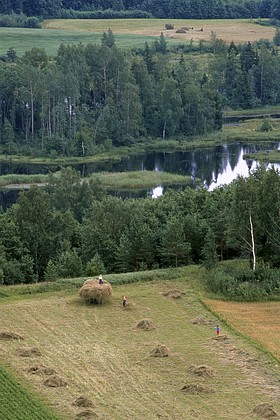Haymaking camps start in beautiful cultural heritage areas
Inviting to participate: Paul Hunt, Eestimaa Looduse Fondist (ELF)
Photo: Arne Ader
Translation: Liis
Haymaking in Võrumaa
Haymaking time has arrived, and in the seminatural heritage areas with their beautiful nature the haymaking will be carried out by many tens of hard-working voluntary nature conservation workers. The great haymaking of the Estonian Fund for Nature, Eestimaa Looduse Fondi (ELF) starts this week already in the areas with the highest flowering plant counts in Estonia – the Nedrema, Viidumäe and Laelatu wooded meadows. A contribution towards saving the diversity of Estonian nature may be to use haymaking techniques that consider the young of animals and birds, or to take part in the voluntary haymaking work. Interested parties can still register on the homepage:
Haymaking in the seminatural heritage areas has always been carried out as a joint effort of men and animals, using traditional working methods and tools. The ELF voluntary workers hold haymaking traditions in high regard. Caring for the semi-natural heritage areas has a long history. In earlier times these areas have been many times larger. Pärandkoosluste Kaitse Ühing (Estonian Seminatural Community Conservation Association) staff member and plant ecologist Jaak-Albert Metsoja remembers the periods of glory: “At the turn of the 19th and 20th century the semi-natural heritage areas were utilized everywhere, in the first place the wooded meadows where husbanding was carried out according to farmers’ wisdom and experiences – the areas were mown once a year and afterwards cattle were let out to graze. This moderate human influence has developed these areas into highly species-rich plant communities that are unique even in a global perspective.“ The uniqueness of the Estonian semi-natural heritage lands is demonstrated by the fact that in the Laelatu wooded meadows a whole of 76 plant species have been identified in one square metre, which is second only to the high-altitude mountain pastures of the Andes in the number of species.
During the 20th century the area of Estonian semi-natural heritage lands has decreased to an extent that endangers both the biotopes themselves and the conservation of their individual species in Estonian nature. A conservation policy is needed with the goal to preserve all the remaining semi-natural heritage areas to the greatest possible extent, and to reinstate the maintenance of semi-natural heritage areas that have fallen out of use.
Beginning on July 10th, haymaking can also be started in semi-natural heritage areas with PRIA support. ELF wishes all haymakers good luck and endurance in their work. We would also like to remind that it is important that haymaking techniques should not endanger the young of animals and birds now moving in the grass that may easily fall victim of fast machines – it is advisable to leave some patches unmown at first, to offer shelter for the young animals and birds. The mowed hay should be collected, and if possible be used as creature fodder. It is advisable not to use cutting techniques where grass crushed by the machine will be left on the ground.
After the haymaking task more than twenty nature conservation cooperative enterprises are coming up and open to join for all interested parties . Details and registering here:









